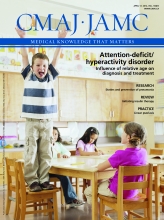Abstract
Background: The annual cut-off date of birth for entry to school in British Columbia, Canada, is Dec. 31. Thus, children born in December are typically the youngest in their grade. We sought to determine the influence of relative age within a grade on the diagnosis and pharmacologic treatment of attention-deficit/hyperactivity disorder (ADHD) in children.
Methods: We conducted a cohort study involving 937 943 children in British Columbia who were 6–12 years of age at any time between Dec. 1, 1997, and Nov. 30, 2008. We calculated the absolute and relative risk of receiving a diagnosis of ADHD and of receiving a prescription for a medication used to treat ADHD (i.e., methylphenidate, dextroamphetamine, mixed amphetamine salts or atomoxetine) for children born in December compared with children born in January.
Results: Boys who were born in December were 30% more likely (relative risk [RR] 1.30, 95% confidence interval [CI] 1.23–1.37) to receive a diagnosis of ADHD than boys born in January. Girls born in December were 70% more likely (RR 1.70, 95% CI 1.53–1.88) to receive a diagnosis of ADHD than girls born in January. Similarly, boys were 41% more likely (RR 1.41, 95% CI 1.33–1.50) and girls 77% more likely (RR 1.77, 95% CI 1.57–2.00) to be given a prescription for a medication to treat ADHD if they were born in December than if they were born in January.
Interpretation: The results of our analyses show a relative-age effect in the diagnosis and treatment of ADHD in children aged 6–12 years in British Columbia. These findings raise concerns about the potential harms of overdiagnosis and overprescribing. These harms include adverse effects on sleep, appetite and growth, in addition to increased risk of cardiovascular events.











